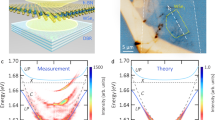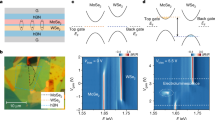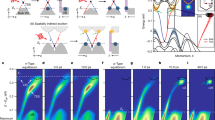Abstract
The emergence of two-dimensional crystals has revolutionized modern solid-state physics. From a fundamental point of view, the enhancement of charge carrier correlations has sparked much research activity in the transport and quantum optics communities. One of the most intriguing effects, in this regard, is the bosonic condensation and spontaneous coherence of many-particle complexes. Here we find compelling evidence of bosonic condensation of exciton–polaritons emerging from an atomically thin crystal of MoSe2 embedded in a dielectric microcavity under optical pumping at cryogenic temperatures. The formation of the condensate manifests itself in a sudden increase of luminescence intensity in a threshold-like manner, and a notable spin-polarizability in an externally applied magnetic field. Spatial coherence is mapped out via highly resolved real-space interferometry, revealing a spatially extended condensate. Our device represents a decisive step towards the implementation of coherent light-sources based on atomically thin crystals, as well as non-linear, valleytronic coherent devices.
This is a preview of subscription content, access via your institution
Access options
Access Nature and 54 other Nature Portfolio journals
Get Nature+, our best-value online-access subscription
$29.99 / 30 days
cancel any time
Subscribe to this journal
Receive 12 print issues and online access
$259.00 per year
only $21.58 per issue
Buy this article
- Purchase on Springer Link
- Instant access to full article PDF
Prices may be subject to local taxes which are calculated during checkout





Similar content being viewed by others
Data availability
The experimental data that support the findings of this study are available in figshare with the identifier https://doi.org/10.6084/m9.figshare.14342471.
Change history
14 May 2021
A Correction to this paper has been published: https://doi.org/10.1038/s41563-021-01036-w
References
Anderson, M. H., Ensher, J. R., Matthews, M. R., Wieman, C. E. & Cornell, E. A. Observation of Bose–Einstein condensation in a dilute atomic vapor. Science 269, 198–201 (1995).
Ketterle, W. & van Druten, N. J. Bose–Einstein condensation of a finite number of particles trapped in one or three dimensions. Phys. Rev. A 54, 656 (1996).
Ketterle, W. Nobel lecture: when atoms behave as waves: Bose–Einstein condensation and the atom laser. Rev. Mod. Phys. 74, 1131–1151 (2002).
Kasprzak, J. et al. Bose–Einstein condensation of exciton polaritons. Nature 443, 409–414 (2006).
Imamoḡlu, A., Ram, R. J., Pau, S. & Yamamoto, Y. Nonequilibrium condensates and lasers without inversion: exciton-polariton lasers. Phys. Rev. A 53, 4250–4253 (1996).
Deng, H., Weihs, G., Snoke, D., Bloch, J. & Yamamoto, Y. Polariton lasing vs photon lasing in a semiconductor microcavity. Proc. Natl Acad. Sci. USA 100, 15318–15323 (2003).
Carusotto, I. & Ciuti, C. Quantum fluids of light. Rev. Mod. Phys. 85, 299–366 (2013).
Weisbuch, C., Nishioka, M., Ishikawa, A. & Arakawa, Y. Observation of the coupled exciton-photon mode splitting in a semiconductor quantum microcavity. Phys. Rev. Lett. 69, 3314–3317 (1992).
Schneider, C., Glazov, M. M., Korn, T., Höfling, S. & Urbaszek, B. Two-dimensional semiconductors in the regime of strong light-matter coupling. Nat. Commun. 9, 2695 (2018).
Wang, G. et al. Colloquium: excitons in atomically thin transition metal dichalcogenides. Rev. Mod. Phys. 90, 021001 (2018).
Lundt, N. et al. Room-temperature Tamm-plasmon exciton-polaritons with a WSe2 monolayer. Nat. Commun. 7, 13328 (2016).
Liu, X. et al. Strong light–matter coupling in two-dimensional atomic crystals. Nat. Photon 9, 30–34 (2015).
Flatten, L. C. et al. Room-temperature exciton-polaritons with two-dimensional WS2. Sci. Rep. 6, 33134 (2016).
Dufferwiel, S. et al. Exciton–polaritons in van der Waals heterostructures embedded in tunable microcavities. Nat. Commun. 6, 8579 (2015).
Lundt, N. et al. Optical valley Hall effect for highly valley-coherent exciton-polaritons in an atomically thin semiconductor. Nat. Nanotechnol. 14, 770–775 (2019).
Dufferwiel, S. et al. Valley-addressable polaritons in atomically thin semiconductors. Nat. Photon 11, 497–501 (2017).
Gu, J. et al. Enhanced nonlinear interaction of polaritons via excitonic Rydberg states in monolayer WSe2. Nat. Commun. 12, 2269 (2021).
Stepanov, P. et al. Exciton–exciton interaction beyond the hydrogenic picture in a MoSe2 monolayer in the strong light-matter coupling regime. Phys. Rev. Lett. 126, 167401 (2021).
Emmanuele, R. P. A. et al. Highly nonlinear trion-polaritons in a monolayer semiconductor. Nat. Commun. 11, 3589 (2020).
Wang, Z. et al. Evidence of high-temperature exciton condensation in two-dimensional atomic double layers. Nature 574, 76–80 (2019).
Malpuech, G., Kavokin, A., Di Carlo, A. & Baumberg, J. J. Polariton lasing by exciton-electron scattering in semiconductor microcavities. Phys. Rev. B 65, 153310 (2002).
Bajoni, D. et al. Dynamics of microcavity polaritons in the presence of an electron gas. Phys. Rev. B 73, 205344 (2006).
Tan, L. B. et al. Interacting polaron-polaritons. Phys. Rev. X 10, 021011 (2020).
Castellanos-Gomez, A. et al. Deterministic transfer of two-dimensional materials by all-dry viscoelastic stamping. 2D Mater. 1, 011002 (2014).
Richard, M., Kasprzak, J., Romestain, R., André, R. & Dang, L. S. Spontaneous coherent phase transition of polaritons in CdTe microcavities. Phys. Rev. Lett. 94, 187401 (2005).
Dufferwiel, S. et al. Valley coherent exciton-polaritons in a monolayer semiconductor. Nat. Commun. 9, 4797 (2018).
Kulakovskii, V. D. et al. Bose–Einstein condensation of exciton polaritons in high-Q planar microcavities with GaAs quantum wells. JETP Lett. 92, 595–599 (2010).
El Daif, O. et al. Nonlinear relaxation of zero-dimension-trapped microcavity polaritons. Appl. Phys. Lett. 92, 081910 (2008).
Adiyatullin, A. F. et al. Periodic squeezing in a polariton Josephson junction. Nat. Commun. 8, 1329 (2017).
Balili, R., Hartwell, V., Snoke, D., Pfeiffer, L. & West, K. Bose–Einstein condensation of microcavity polaritons in a trap. Science 316, 1007–1010 (2007).
Jakubczyk, T. et al. Radiatively limited dephasing and exciton dynamics in MoSe2 monolayers revealed with four-wave mixing microscopy. Nano Lett. 16, 5333–5339 (2016).
Daskalakis, K. S., Maier, S. A. & Kéna-Cohen, S. Spatial coherence and stability in a disordered organic polariton condensate. Phys. Rev. Lett. 115, 035301 (2015).
De Giorgi, M. et al. Interaction and coherence of a plasmon-exciton polariton condensate. ACS Photonics 5, 3666–3672 (2018).
Yakovlev, D. R. et al. Combined exciton-cyclotron resonance in quantum well structures. Phys. Rev. Lett. 79, 3974–3977 (1997).
Koperski, M. et al. Orbital, spin and valley contributions to Zeeman splitting of excitonic resonances in MoSe2, WSe2 and WS2 monolayers. 2D Mater. 6, 015001 (2018).
Lundt, N. et al. Magnetic-field-induced splitting and polarization of monolayer-based valley exciton polaritons. Phys. Rev. B 100, 121303 (2019).
Wang, G. et al. Spin-orbit engineering in transition metal dichalcogenide alloy monolayers. Nat. Commun. 6, 10110 (2015).
Schneider, C. et al. An electrically pumped polariton laser. Nature 497, 348–352 (2013).
Gu, J., Chakraborty, B., Khatoniar, M. & Menon, V. M. A room-temperature polariton light-emitting diode based on monolayer WS2. Nat. Nanotechnol. 14, 1024–1028 (2019).
Acknowledgements
This work was funded by the Deutsche Forschungsgemeinschaft (DFG, German Research Foundation)–INST 93/932-1 FUGG. The authors gratefully acknowledge funding by the State of Bavaria and Lower Saxony. Funding provided by the European Research Council (ERC project 679288, unlimit-2D) is acknowledged. T.H.H., S.K. and S.H. acknowledge financial support by DFG through the Würzburg-Dresden Cluster of Excellence on Complexity and Topology in Quantum Matter “ct.qmat” (EXC 2147, project‐id 390858490). T.H.H. acknowledges funding by the doctoral training program ‘Elitenetzwerk Bayern’ and support by the German Academic Scholarship Foundation. S.T. acknowledges funding from NSF DMR 1955889, DMR 2111812, DMR 1933214 and 1904716. S.T. also acknowledges DOE-SC0020653. E.S. and A.V.K. acknowledge Westlake University (project number 041020100118) and Program 2018R01002 funded by the Leading Innovative and Entrepreneur Team Introduction Program of Zhejiang. K.W. and T.T. acknowledge support from the Elemental Strategy Initiative conducted by the MEXT, Japan, grant number JPMXP0112101001, JSPS KAKENHI grant number JP20H00354 and the CREST (JPMJCR15F3), JST. A.V.K. acknowledges the St Petersburg State University for research grant number 73031758.
Author information
Authors and Affiliations
Contributions
The experiments were performed by C.A.-S. and M.W., with contributions from M.K. and T.H.H. The data analysis was performed by C.A.-S. and M.W., with contributions from T.H.H., S.K. and C.S. The Epi wafer was designed by C.S. and S.H., and grown by H.S. The device was built by M.W. Crystals were provided and customized by H.C., S.T., K.W. and T.T. The theory and simulations were performed by E.S. and C.S. with contributions from C.A.-S. and with the supervision of A.V.K. The project was supervised by C.S. All the authors participated in the writing of the manuscript.
Corresponding authors
Ethics declarations
Competing interests
The authors declare no competing interests.
Additional information
Peer review information Nature Materials thanks the anonymous reviewers for their contribution to the peer review of this work.
Publisher’s note Springer Nature remains neutral with regard to jurisdictional claims in published maps and institutional affiliations.
Supplementary information
Supplementary Information
Supplementary Sections 1–7, Figs. 1–10 and references.
Rights and permissions
About this article
Cite this article
Anton-Solanas, C., Waldherr, M., Klaas, M. et al. Bosonic condensation of exciton–polaritons in an atomically thin crystal. Nat. Mater. 20, 1233–1239 (2021). https://doi.org/10.1038/s41563-021-01000-8
Received:
Accepted:
Published:
Issue Date:
DOI: https://doi.org/10.1038/s41563-021-01000-8
This article is cited by
-
Energy transfer driven brightening of MoS2 by ultrafast polariton relaxation in microcavity MoS2/hBN/WS2 heterostructures
Nature Communications (2024)
-
Polarization superposition of room-temperature polariton condensation
Communications Materials (2023)
-
Macroscopic transition metal dichalcogenides monolayers with uniformly high optical quality
Nature Communications (2023)
-
Strongly enhanced light–matter coupling of monolayer WS2 from a bound state in the continuum
Nature Materials (2023)
-
Coherent propagation of spin-orbit excitons in a correlated metal
npj Quantum Materials (2023)



